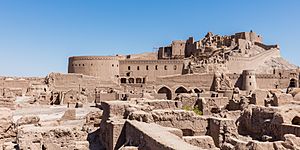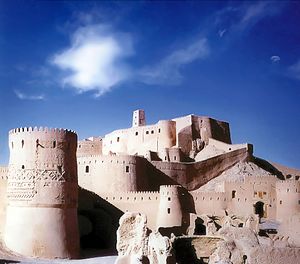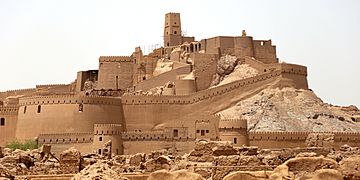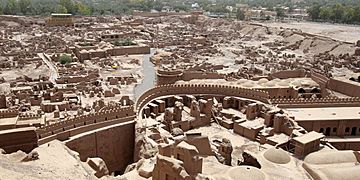Arg-e Bam facts for kids
| UNESCO World Heritage Site | |
|---|---|
 |
|
| Location | Bam, Iran |
| Part of | Bam and its Cultural Landscape |
| Criteria | Cultural: ii, iii, iv, v |
| Inscription | 2004 (28th Session) |
| Endangered | 2004–2013 |
The Arg-e Bam (which means "Bam Citadel" in Persian) is a huge fortress located in the city of Bam, in southeastern Iran. It's known as the largest adobe (mud brick) building in the world! Even though the whole area was a big fortress, the main part, the citadel, was so important that the entire place is now called the Bam Citadel.
UNESCO has listed it as part of the "Bam and its Cultural Landscape" World Heritage Site. This amazing place dates back a very long time, possibly to the Achaemenid Empire (around 6th to 4th centuries BC). It became very important between the 7th and 11th centuries because it was a key stop along the famous Silk Road and other important trade routes. It was also known for making silk and cotton clothes.
Sadly, on December 26, 2003, a powerful earthquake almost completely destroyed the citadel. Much of the city of Bam was also ruined. Just a few days after the earthquake, the President of Iran promised that the citadel would be rebuilt.
Contents
History of Bam Citadel
We don't have exact dates for when each part of the Bam Citadel was built. But old writings tell us that people first settled here during the Achaemenid Empire, between 579 and 323 BC. Some parts of the citadel, like how it's built on a natural hill combined with a man-made platform, are similar to the Achaemenian city of Persepolis.
During the Parthian Empire, the fort grew bigger and became known as Arg-e-Bam. Experts believe that the main part of the city and the governor's area were built during this time. Later, under the Sasanian Empire, new walls and defenses were added between 224 and 637 AD.
In 645 AD, the area was taken over by the Arabs. The Arg-e-Bam likely got damaged during this war. One of the Arab leaders built the Al Rasoul mosque here, which was one of the first mosques in Iran. Later, in 869 AD, Ya'qub ibn al-Layth al-Saffar took control of Arg-e-Bam and made it his main base. Islamic writers first mentioned Bam in the 10th century. They described it as a busy market town with lots of farms, famous for its cotton fabrics, strong fortress, lively markets, and palm trees.
After the Mongols came to Iran, the Kerman region, including Bam, was ruled by the Qarakhataian family from 1240 to 1363 AD. Bam was important because it was on the spice route, which connected to the Silk Road. The city was also known for raising silkworms and making silk.
The Safavid dynasty ruled Iran from 1502 to 1722, a time of peace. Arg-e-Bam, like the rest of the country, grew a lot during this period. The "Four Seasons Palace" was built then. Towards the end of Safavid rule, Agha Mohammad Khan, who started the Qajar dynasty, took over Arg-e-Bam. He used it as a military base to protect against attacks. Because of more soldiers living inside, people slowly started to move outside the fortress walls. By 1880, only military people lived inside the citadel. In 1900, the new city of Bam began to be built, and people gradually left the old city.
The citadel was used by soldiers until 1932. After that, both the military base and the old city were left empty. In 1953, it was recognized as an important historical site. Work to protect and restore it began slowly, but most of the restoration happened from 1973 onwards. After the Islamic Revolution, the Cultural Heritage Organization of Iran took charge of Arg-e-Bam. In 1993, it was named one of their most important projects.
Citadel Design and Architecture
The way the Bam Citadel was planned and built is very clever. It seems the builders knew exactly how the whole city and fortress would look from the very beginning. As they added new parts, everything fit together perfectly.
The citadel itself is in the middle of the fortress-city, on the highest point. This was for safety, giving a wide view of the area.
The citadel has two main parts:
- The Rulers' Area: This is the most protected part, inside the innermost wall. It included the main citadel building, barracks for soldiers, a mill, the "Four Seasons House," a deep water well (about 40 meters or 130 feet deep), and stables for 200 horses.
- The Common People's Area: This part surrounded the rulers' area. It had the main entrance to the whole fortress-city and the bazaar (market). There were also about 400 houses and public buildings like a school and a sports area.
The houses were different sizes:
- Smaller houses with 2-3 rooms for poorer families.
- Larger houses with 3-4 rooms for middle-class families. Some of these even had a porch.
- The most luxurious houses had many rooms facing different directions for different seasons. They also had a large courtyard and stables nearby. There were only a few of these grand houses.
All the buildings were made from adobe, which are bricks made of non-baked clay. Before the 2003 earthquake, Bam Citadel was probably the largest adobe structure in the world.
Description of the Citadel
The citadel is made up of four main sections: a place for people to live (residential zone), stables for animals, barracks for the army, and the governor’s residence.
Arg-e-Bam had 38 watchtowers and four entrance gates. A moat (a deep ditch filled with water) surrounded the outer defense wall. The Government Quarters were on a rocky hill, protected by two strong walls. Some of the most famous buildings include the bazaar, the main Mosque, and the Mir House.
Dimensions
The Bam Citadel is bigger than the nearby Rayen Castle. It covers about 180,000 square meters (44 acres). It's surrounded by huge walls that are 6 to 7 meters (20-23 feet) high and 1,815 meters (5,955 feet) long. The citadel also has two of the famous "stay-awake towers" that Bam is known for. There are as many as 67 such towers scattered across the ancient city of Bam.
The 2003 Earthquake
On December 26, 2003, at 5:26 in the morning, a major earthquake hit Bam. The United States Geological Survey said it had a magnitude of 6.6 on the Richter scale. At that time, about 142,000 people lived in the Bam area. This extremely powerful earthquake killed about 26,200 people, injured thousands, and left more than 75,000 people without homes. About 70% of the buildings in the city were destroyed. The earthquake was so damaging because its center was very close to the city of Bam, only about 7 kilometers (4.3 miles) deep.
The Bam area has many underground cracks in the Earth's crust called faults. The main one, called the Bam Fault, had been quiet for a very long time. The earthquake caused a lot of shaking, and many buildings that were built facing north-south were badly damaged. Buildings that faced east-west, however, held up much better.
It was also noticed that buildings that had been repaired or changed many times over the years fared much worse than older structures that had not been touched. Even some buildings that had been strengthened recently were badly damaged.
Consequences of the Earthquake
The citadel, including the governor’s residence, the main tower, the Chahar Fasl (Four Seasons) turret, and the hammam, were almost completely destroyed. This was especially true because they were located on top of a hill, which made the earthquake's energy even stronger there. Also, these buildings collapsed because their foundations were on uneven ground, made of rocks and earth fill, which shifted during the shaking. The city at the bottom of the castle was almost completely flattened, especially the parts that had been restored before. Most of the arched roofs cracked or were severely damaged.
Interestingly, some parts of the city that had not been restored before the earthquake, and were already very old and ruined, suffered less damage. For example, the Konariha quarter, which was already in bad shape, did not get as much damage as the restored parts of the city. Only a few walls fell, and some already broken roofs collapsed.
Similarly, the Zoroastrian temple behind Arg-e-Bam and the Khale Dokhtar citadel, 2 kilometers north of Arg-e-Bam, were already very ruined before the earthquake. They did not get as much damage as the restored city of Arg-e-Bam. The Khale Dokhtar citadel is believed to be even older than Arg-e-Bam.
Three kilometers east of Arg-e-Bam, the Summer Pavilion and an old caravanserai (a roadside inn for travelers) were not damaged much further by the earthquake. The caravanserai had been abandoned long ago. It seemed to have been built very well, which helped it survive better than other buildings in the area.
Gallery
- Arg-e Bam
Images for kids
-
The citadel of Arg-e Bam before the earthquake
See also
 In Spanish: Arg-é Bam para niños
In Spanish: Arg-é Bam para niños
- List of Iranian castles
- Iranian architecture
- List of World Heritage Sites in Iran









